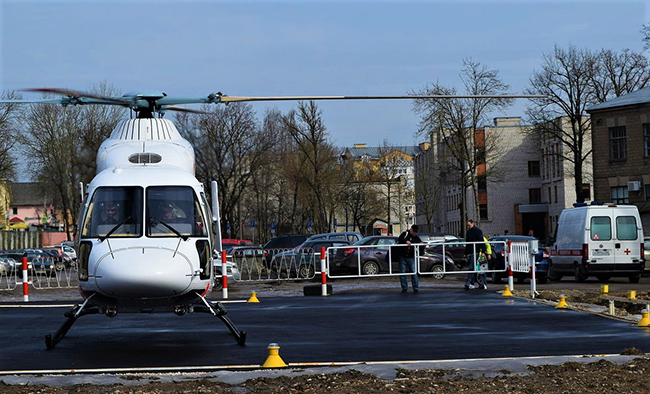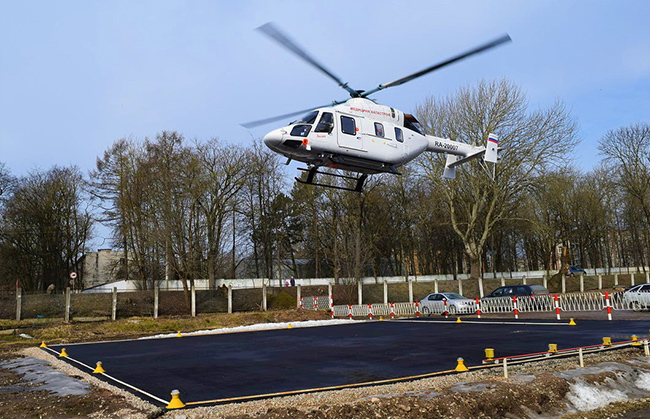- Hello Andrey Ivanovich. Thank you for taking the time to answer our questions. To begin with could you tell me how long have you been working in aviation, where did you study and how did you decide to relate your life with aviation?
- Aviation is the best years of my life. In due time I have finished the Riga institute of civil aircraft on a specialty "Exploitation of flying machines and engines". Then there was a military service - an officer of military transport aviation as a technician, an IL-76 on-board technician. Then - Aeroflot, technician, engineer, airborne mechanic An-24 and An-26. In 2011-2016 again, by chance, I was in aviation - the organisation of air patrolling of the forest fund in the Pskov region. Since September 2017 I have been working in the RHS. Familiar and understandable to me the work with its features. I was a member of the flight crew and therefore I know and understand both the flight and the technical side of organising and performing flights. I like what I do. In life, it seems to me, it is necessary to be guided by the principle "Choose your work for the soul and you do not have to work a single day in your life ..." (Confucius)
- What are your current work days? Which patients most often had to be evacuated?
- More than 50% - patients with vascular pathology, acute myocardial infarction, acute coronary syndrome, acute violation of cerebral circulation. Patients with such diseases require urgent hospitalisation and the rule of the "Golden Hour" in such situations is especially important.
- How is the interaction with the health structures of the region carried out?
- The customer receives daily reports on completed requests and on duty. Before the commencement of the duty, the customer is informed of the weather conditions by the flight regions. Since the beginning of work in 2017, we have been able to significantly improve the effectiveness of interaction with all relevant services, and as a result, to avoid wasting time. More promptly respond and fulfil incoming requests to us.
- What helicopters do you fly? How do they differ from conventional helicopters in their equipment? What do doctors say about your technique?
- We are flying the new modern Russian helicopter Ansat with a medical module corresponding to the equipment of Class C reanimobiles. In 2018, the specialists of the engineering and technical staff of our company for the first time in Russia carried out work to expand the ergonomic capabilities of the medical module for evacuation of two stretcher victims, which significantly increased the capacity of the sanitary version of the Ansat.
The doctors' comments on equipping the helicopter and the possibility of access to the patient are only positive. The medical staff appreciates the ergonomics and spaciousness of the cabin. There is an opportunity not only to comfortably accommodate the victim, but also to carry out a full range of necessary medical procedures.
- How many people were evacuated from the beginning of the work of air medical service in the region?
- During 4 months of 2017, 76 patients were transported. For the first 6 months of 2018 we have already transported 66 patients. In 2018, we expect this figure to double. In total, 142 patients were transported from 2017.
- The specifics of the air medical service - long expectations in full "combat readiness". What do the crews do in their free time?
- One hour before the arrival on duty, the engineering and technical personnel (ITP) prepares the helicopter for flights, the pilots study the meteorological situation, the introduction of restricted flight zones along possible routes. As a rule, the crew is ready to fly more quickly than stipulated by the regulations. In these restrictions, the flight crew and ITP do not have the opportunity to deal with other matters. On days off from duty, pilots and ITPs are engaged in professional training and carrying out the necessary periodic work on the helicopter.
- Do air medical service pilots themselves have first aid skills?
- Theoretical rules for first aid are included in the training course for our pilots. In addition, we regularly conduct practical trainings. Pilots must be prepared for completely different situations, for this they constantly improve their skills.
- Let's explain to our readers why it's a helicopter, not an airplane. What is the fundamental difference?
- First of all - in its mobility, flexibility in the use of helicopter technology. The helicopter has the opportunity to sit on an unprepared and limited area, it does not need developed airfield networks, which significantly reduces the time of rendering assistance to the victim. The use of the helicopter significantly expands the geography, efficiency and effectiveness of medical care.
- How do you assess the prospects for the development of air medical service in the region? What would you add or remove, how to make the work more productive, and the conditions for development more comfortable?
- The fact that air medical service is a necessary and demanded business, it seems to me, does not cause any doubts today. The system of rendering emergency medical aid will develop, while the priority program for the development of air medical service operates. What will happen next if funding is provided only from regional budgets is difficult to foresee. I hope that the intensive pace of development that we have taken, we can continue to support. I can note that the state program has allowed, for the first time since the collapse of the USSR, to restore the effective work of air medical service in a significant territory of Russia, which ultimately saves lives for thousands of our fellow citizens.
- Now you can evaluate the specific features of the work of air medical service. Were there unusual cases that you especially remember?
- The main specificity is air medical service itself - the need to make the safest and most effective decisions on flight operations as well as on providing medical care to patients as quickly as possible. Life is like a kaleidoscope, you never know what challenges you face. The key to the successful completion of the task is the well-coordinated work of all components: helicopter equipment and ground equipment, technical and dispatch services, helicopter crew, medical team and medical staff.
From the regional specifics - there are two residential islands on the Pskov lake. During ice-freezing and ice drift, communication with the islands is carried out only by means of a helicopter. In fact, we were tasked with establishing a "medical bridge" to provide residents of the islands with conditions for obtaining prompt and qualified medical care. We were selected and flew around the site on the islands, established a permanent connection with the administration. They flew away - they brought the patient. Everything is normal - this is our job.
The most important and most important achievement is our team. I am sincerely glad that I again had the opportunity to work in aviation shoulder to shoulder with high-class pilots, technicians, dispatchers, master new promising equipment and contribute to the revival of domestic air medical service.















